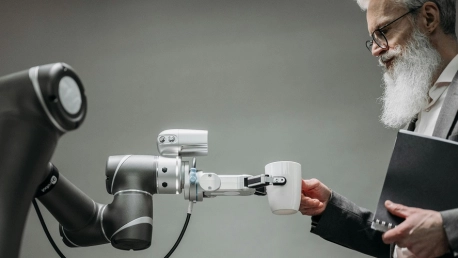As AI becomes less of an occasional tool and more like a colleague, the needs and goals of organizations will need to be more integrated with information technology. Alongside AI uses, the importance of human sustainability is growing, making talent management increasingly crucial for workers. Right now, HR is at a crossroads, becoming less of a personnel and management tool and more of an agility-oriented service. Let’s see how the workplace will look in 2034 with the help of HR:
Impact of Hybrid and Remote Work on Productivity Management
The rise of hybrid and remote work has produced a greater need for organizations to track employee productivity. According to Gartner, around 16% of employers use technology to gather data on workplace productivity. From virtual clocking in and out to overseeing employee emails and work computer usage, these monitoring practices have increased since the COVID-19 pandemic.
Some companies have the technology to track employees’ biorhythms and exercise needs to track their well-being and alarm them when it is time to step away from the computer to rest and recharge. Some companies worry about employees’ mental health in this way, but most are far from such accommodating practices. However, in the future, we expect more enterprises to use this technology to analyze the connection between employee satisfaction, well-being, and productivity.
From Tool to Colleague: AI’s Role in Future Workplaces
Machine learning has allowed programs to complete tasks that were once possible only for humans. Companies are adopting many smart apps and virtual assistants to increase productivity. Employees can also rely on these software programs and devices to create virtual doppelgängers or counterparts that assist them in their tasks. The rising demand for automation has resulted in a powerful combination of people and technology.
In the future, we can expect AI to become less of a tool and more of a colleague. Technology brings a new level of automation and Intelligence to HR, so human resources managers could become talent scouts and coaches by 2034, guiding and helping individual careers rather than getting smothered in paperwork.
Aligning Jobs with Purpose, Mission, and Passions
Employees actively search for opportunities to do valuable work and align their jobs with their purpose, mission, and passions. It is no longer enough to promise money to employees to pile tasks on them. HR will increasingly have to promise social innovation and equity to people to attract and retain top talent. Job descriptions might revolve more around how the position can make a meaningful difference instead of a long list of responsibilities. Despite the hybrid and remote workforce, people want to feel like a part of a community; therefore, leaders need to continue creating initiatives to connect with their people and provide them with the space to share their personal stories.
Evolution of HR Roles in Response to Changing Workforce Dynamics
The social and political turmoil is affecting how managers achieve their responsibilities. The workforce has changed with a heightened sensitivity and necessity for hybrid employment and work-life balance. These factors put pressure on middle management, which has more workers to lead than ever.
Personalized assistance from manager to employee is also more difficult due to the manager-worker ratio and all the workers’ needs for more flexibility regarding work hours and location.
Therefore, it is not enough to have organizational capabilities as a manager because from now on, HR will be looking for great coaches and teachers who lead with empathy and mindfulness.
HR roles are already changing and evolving:
As the nature of management and the workforce environment change, HR will have to follow. In ten years, we might see a demand for these positions in HR:
- HR data scientists, or HR chief technology officers, will oversee the expansion of employee data collection. This position will evolve into the head of HR as organizing data and reporting will play a significant role in Leveraging Technology and Data Analytics in Recruitment. Don’t worry. This job won’t be as dry as it sounds. You will have many AI assistants to keep you company. All the data collection will be the duty of the algorithm, while the head of HR will compile and analyze this data with a human-first approach.
- Employee experience specialists will create, implement, and manage strategies to improve employee experience. Their primary mission is to design a positive, engaging, and, as a consequence, a productive work environment that uplifts morals, drives employee satisfaction, and, therefore, enhances retention for the company.
- Head of the candidate experience will have the challenging task of making the hiring process as fast, convenient, and efficient as a one-click shopping experience, both for the employee and the company. The central part of their work will require them to communicate with candidates at every stage of the hiring process, promising timely and transparent responses and a personable experience overall. They will also have to integrate innovative technology to ensure the recruitment process is cut to a portion of its current time.
- A performance coach will be a problem-solving person who works to optimize the performance of management and non-management personnel. They act as an accountability partner who provides structure and support to teams to help them stay accountable and motivated.
- Organizational psychologists do not offer one-on-one sessions with employees but use principles of psychology to develop a more holistic approach to HR. Although it is not traditionally a technical HR position, in 10 years, it could be very coveted, especially as marketing and sales departments evolve and their need for integrated practices grows.
Remote Work-life Balance Will Not Come Without Challenges
Despite what many people used to think before the pandemic about remote working, or rather, slacking, studies have shown that employees who work independently are more likely to overwork themselves. As a result, the fluid workforce requires a better work-life balance to avoid burnout.
However, we still have many challenges to face before employees can prioritize their personal lives over work. As technology allows people to work together regardless of physical distance, it can erode relationships and make it harder for employees to build social connections. Without healthy human contact, people can feel disengaged and lonely.
To remedy this issue, CEOs and HR leaders must ensure that employees’ workloads and schedules change with their life stages. It is one of the 7 pillars of a healthy organizational culture. Workloads impact the mental health of millions of workers in the US, with 31% reporting emotional exhaustion in 2023. That is why leaders need to start leading with empathy and stop managing to optimize productivity and allow people the space to balance work and personal lives.
Slowly Moving Towards Boundaryless HR
As mentioned above, traditional boundaries within HR responsibilities are already dissolving. The conventional practice of HR managers who are in charge of supervising employment, focusing on compliance and control, is already evolving into agile HR. It is a collaborative effort to adapt HR to an AI-powered market where the focus has shifted to skills-first hiring instead of looking at experience and education.
In 2034, we will have boundaryless HR, a fully cross-functional system where personal management finally achieves its true form. HR will evolve from talent management to a discipline wholly integrated into all company levels, orchestrating a synergy of humans and machines to drive better business outcomes, with the end goal of human sustainability.
Conclusion
The pandemic has changed offices, people, and hiring practices. The future of work looks more and more like a scene from a sci-fi movie. Life imitates art, as they say. Organizations must be proactive in making new work patterns, as it is vital to their survival. Besides attracting and retaining talent, we must rethink our workloads, HR, and communication to create an innovative, inclusive, and insightful workplace.
“Human resources are like natural resources; they’re often buried deep. You must look for them; they’re not just lying on the surface. You have to create the circumstances where they show themselves.”
—Ken Robinson, former director of the Arts in Schools Project
In conclusion, the workplace is heading towards a very different-looking landscape. As AI evolves from a simple tool to a supportive colleague, HR’s role becomes more agile, and the rise of hybrid and remote work will require our full focus on productivity management and employee well-being. The evolving HR roles already reflect the changing dynamics of this shifting workforce landscape. Ultimately, the future is a vision of a seamless integration of humans and technology, where workers can align their careers to their passions instead of trying to fit in where they are unhappy. HR supports this integration for now, but as we evolve into boundaryless HR, it will drive people and businesses toward better outcomes while prioritizing human sustainability.









